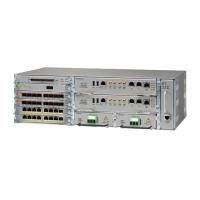Electromagnetic Interference
All equipment powered by AC current can propagate electrical energy that can cause EMI and possibly affect
the operation of other equipment. The typical sources of EMI are equipment power cords and power service
cables from electric utility companies.
Strong EMI can destroy the signal drivers and receivers in the Cisco ASR 903 and even create an electrical
hazard by causing power surges through the power lines into installed equipment. These problems are rare
but could be catastrophic.
To resolve these problems, you need specialized knowledge and equipment that could consume substantial
time and money. However, you can ensure that you have a properly grounded and shielded electrical
environment, paying special attention to the need for electrical surge suppression.
For information about the electrode magnetic compliance standards supported on the Cisco ASR 903 Router
as a satellite shelf, see Regulatory Compliance and Safety Information for the Cisco ASR 903 Router.
Radio Frequency Interference
When electromagnetic fields act over a long distance, radio frequency interference (RFI) may be propagated.
Building wiring can often act as an antenna, receiving the RFI signals and creating more EMI on the wiring.
If you use twisted-pair cable in your plant wiring with a good distribution of grounding conductors, the plant
wiring is unlikely to emit radio interference. If you exceed the recommended distances, use a high-quality
twisted-pair cable with one ground conductor for each data signal.
Lightning and AC Power Fault Interference
If signal wires exceed the recommended cabling distances, or if signal wires pass between buildings, you
should consider the effect that a lightning strike in your vicinity might have on the Cisco ASR 903 Router as
a satellite shelf.
The electromagnetic pulse (EMP) generated by lightning or other high-energy phenomena can couple enough
energy into unshielded conductors to damage or destroy electronic equipment. If you have previously
experienced such problems, you should consult with RFI and EMI experts to ensure that you have adequate
electrical surge suppression and shielding of signal cables in your Cisco ASR 903 Router as a satellite shelf
operating environment.
Rack-Mounting Guidelines
These sections provide guidelines for rack-mounting the Cisco ASR 903 Router as a satellite shelf:
Rack-Mounting Precautions
These rack-mount guidelines are provided to ensure your safety:
•
Do not move large racks by yourself. Due to the height and weight of a rack, a minimum of two people
are required to accomplish this task.
•
Ensure that the rack is level and stable before extending a component from the rack.
•
Ensure that proper airflow is provided to the components in the rack.
Cisco ASR 9000 Series Aggregation Services Router Satellite Systems Installation Guide
15
Installing the Cisco ASR 903 Router as a Satellite Shelf
Rack-Mounting Guidelines

